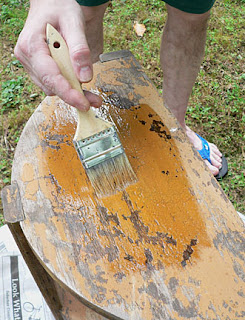 Some pieces of furniture, especially those constructed of harder woods, such as walnut, mahogany, maple, oak, or cherry, may only need to have their surface finish preserved. In the case of furniture made of these woods, there may be enough of the original finish left to restore the piece rather than refinish it.
Some pieces of furniture, especially those constructed of harder woods, such as walnut, mahogany, maple, oak, or cherry, may only need to have their surface finish preserved. In the case of furniture made of these woods, there may be enough of the original finish left to restore the piece rather than refinish it.Before doing anything, study your piece. Is the finish pretty much intact? Does the piece have a nice patina? Is the piece more than 100 years old? If you answered yes to even one of these questions, then you should do your best to preserve the finish of your piece.
The first step to preservation is cleaning. Furniture gets dirty, even grimy over time. Before you can apply a new finish, you need to get rid of all the accumulated dirt and grease that often make it difficult to tell what kind of wood the piece of furniture is made of. Grime can also hide the fine lines of inlay and marquetry. Believe it or not, using lemon oil, a popular furniture polish, can do more harm than good. Since its made of a light petroleum oil and some paraffin wax, the wood doesn’t absorb it. Instead, it acts as a surface dust catcher.
One of the best products for cleaning wood, especially furniture, is Murphy’s Oil Soap. Today, it’s also in a spray bottle, but in case you can’t find it that way, you can make your own cleaning solution by mixing a capful of Murphy’s in a spray bottle of water. For this, you can use any empty spray cleaner bottle, as long as you wash it out thoroughly first. Since water will loosen any glued joint, and also tends to raise the grain of the wood, you don’t’ want to use very much. An old washcloth will do quite well for cleaning.
Spray the Murphy’s on a damp washcloth and then rub it on the surface of the furniture. Rinse the cloth when it gets to dirty. Have a second wet, but wrung out, washcloth ready to wipe off the Murphy’s Oil solution, wringing the cloth nearly dry after every few wipes. You can also use a green scruby cloth, sold in Dollar Stores, if there’s hard to remove grime. A stiff-bristle brush will allow you to get the dirt out of carved and turned areas. The secret is to clean only a small area at a time–one leg of a chair, one part of a chest, and so on. After you clean an area, wipe it dry with an old face towel. Be sure to wash out all your cloths or use others as you progress, especially on a large piece of furniture. After you have finished cleaning your piece of furniture, give it a final wipe with a clean cotton rag and set it aside to dry for 24 hours.
 Now you’re ready to apply a new finish. You can either use plain tung oil (see last week’s blog) or a product like Minwax® Water-Based WoodSheen® which is a water-soluble mixture of furniture finish and stain that comes in six colors. For a piece that’s got lots of scratches or marks, it’s best to choose a stain color that complements the wood’s original finish.
Now you’re ready to apply a new finish. You can either use plain tung oil (see last week’s blog) or a product like Minwax® Water-Based WoodSheen® which is a water-soluble mixture of furniture finish and stain that comes in six colors. For a piece that’s got lots of scratches or marks, it’s best to choose a stain color that complements the wood’s original finish. The final step is polishing the entire piece using a prepared wax like Minwax, which comes in light and dark varieties. Obviously, use the light for woods like oak or cherry and the dark for woods like walnut or mahogany. Apply the wax with a piece of soft cotton cloth like an old athletic sock and after 30 minutes, polish the surface with an old face towel. One coat should do it, but for tabletops, apply two coats of wax.
Rub off the first coat with 0000 steel wool, then apply the second and polish with the towel. The more coats of wax you apply, the more water resistant the top will become. A light polishing once or twice a year will keep your piece in great condition.
There are no short cuts or time savers to this entire process. The work can be slow and at times tedious, but the results are worth it.











